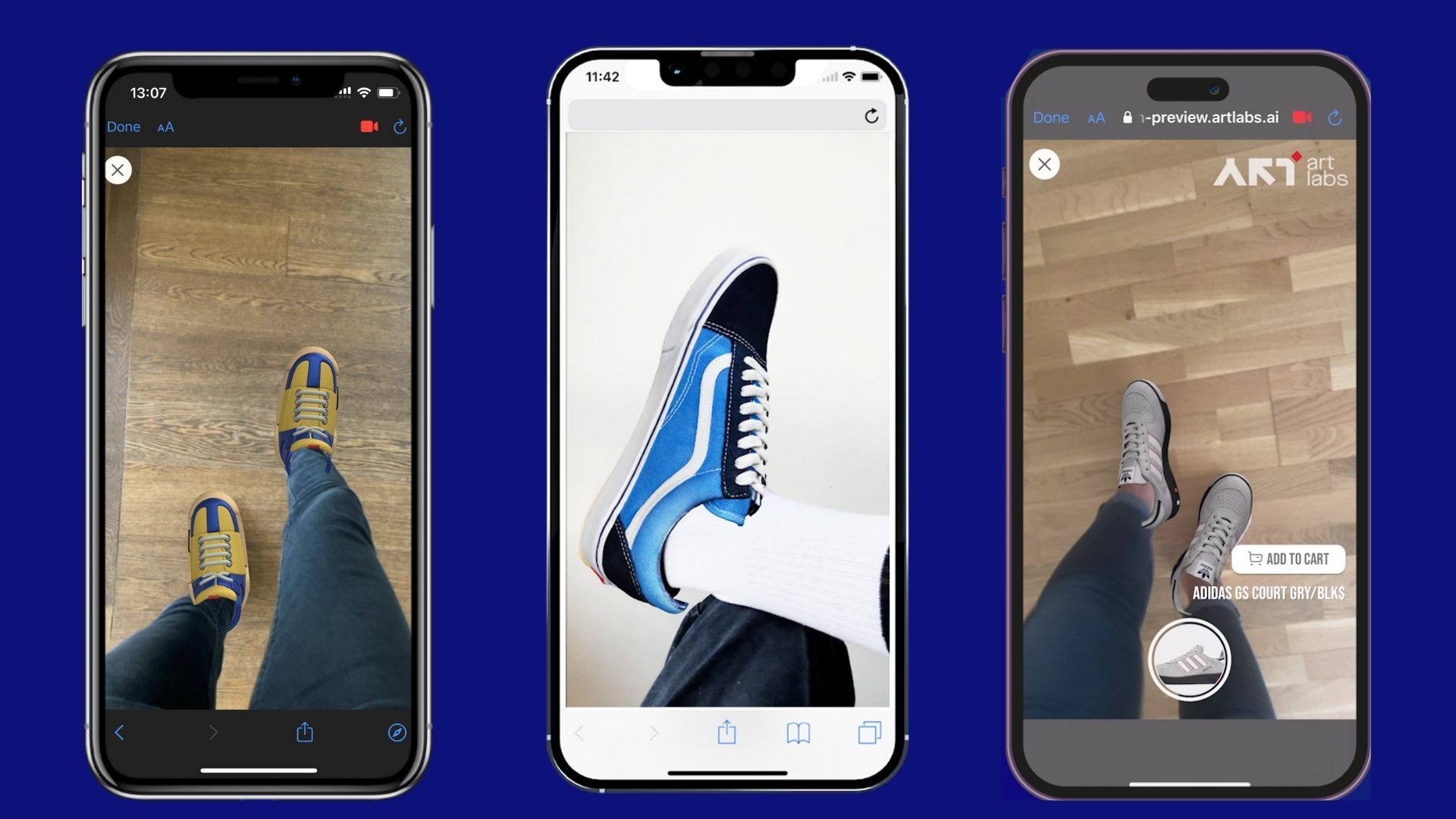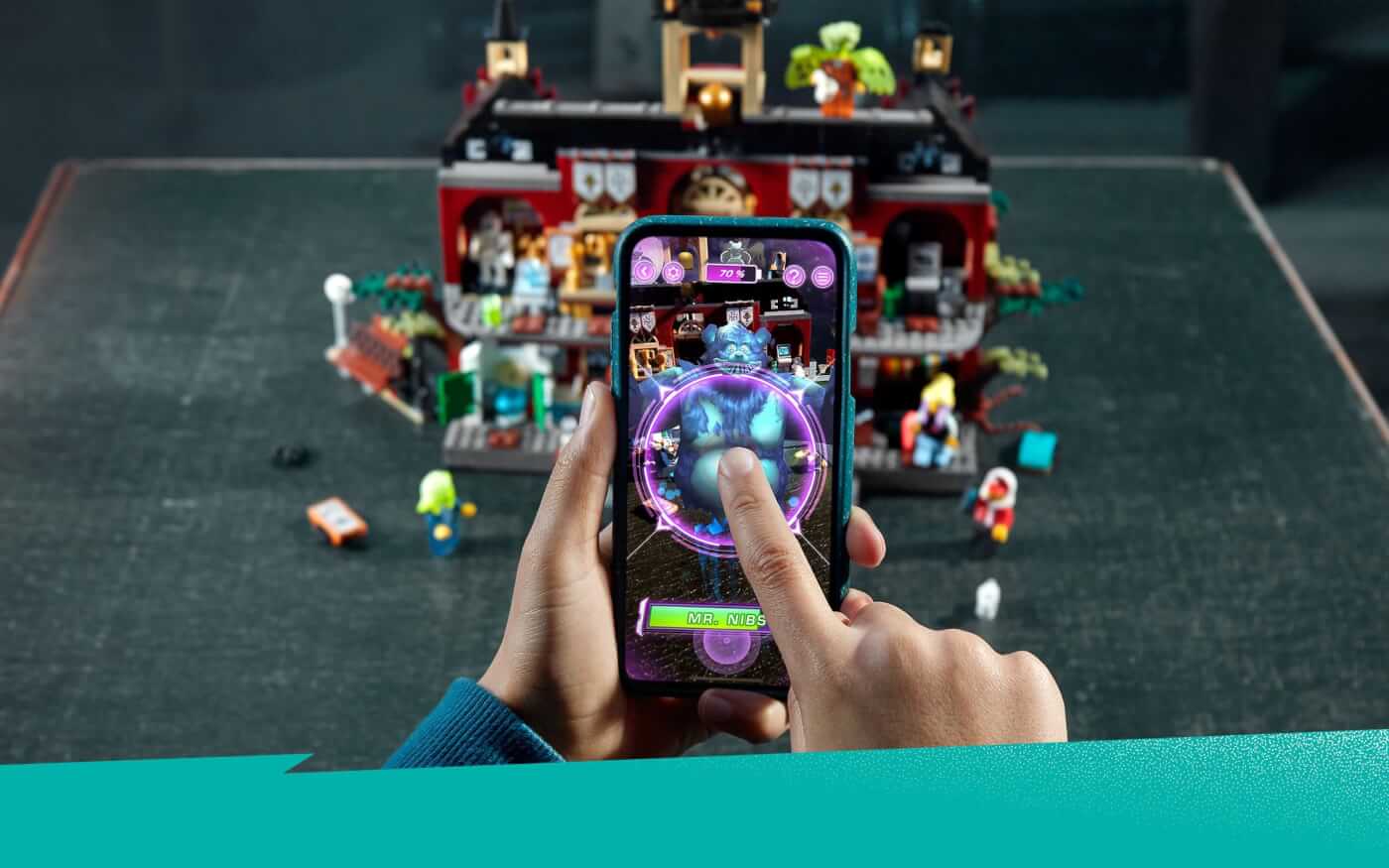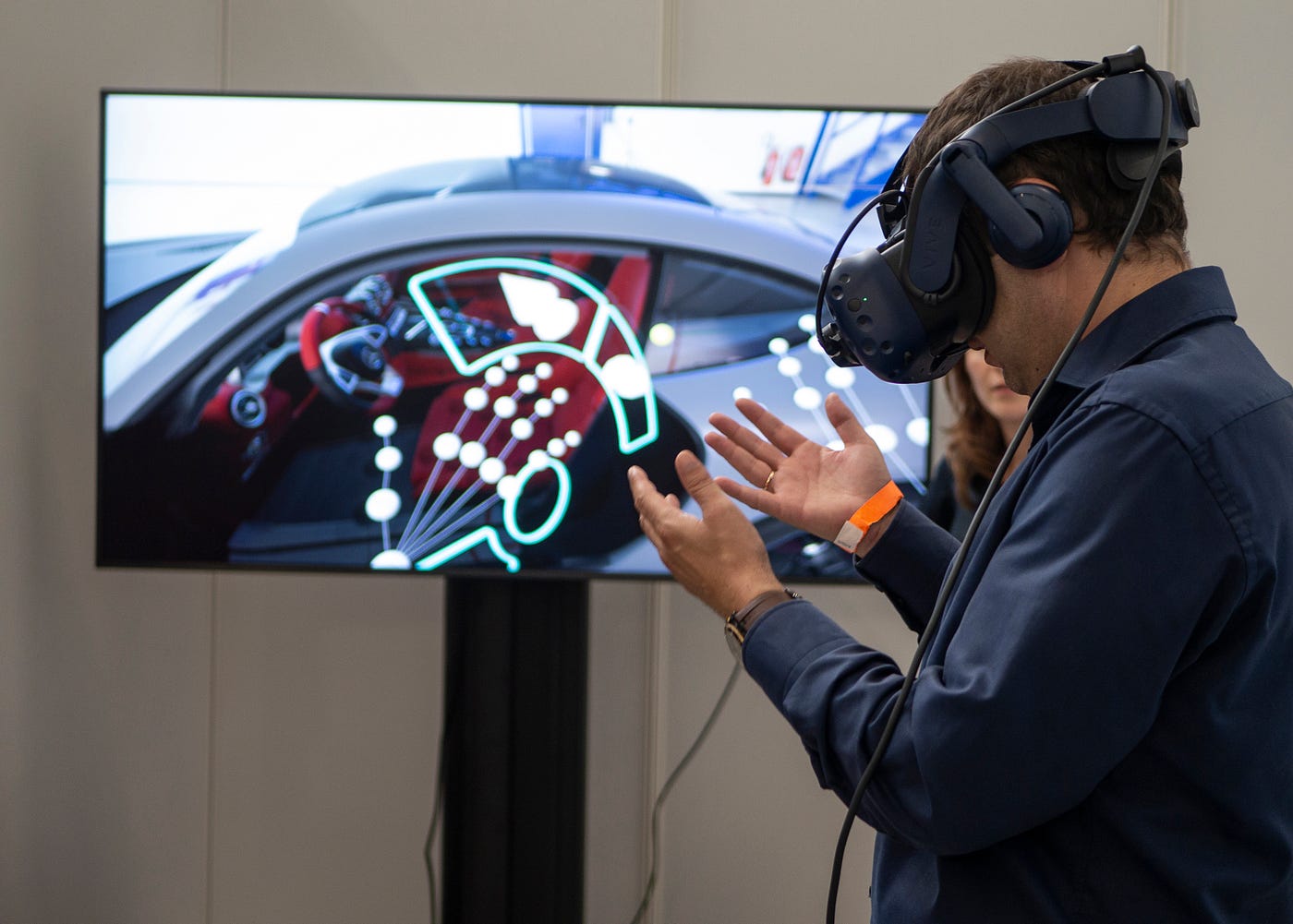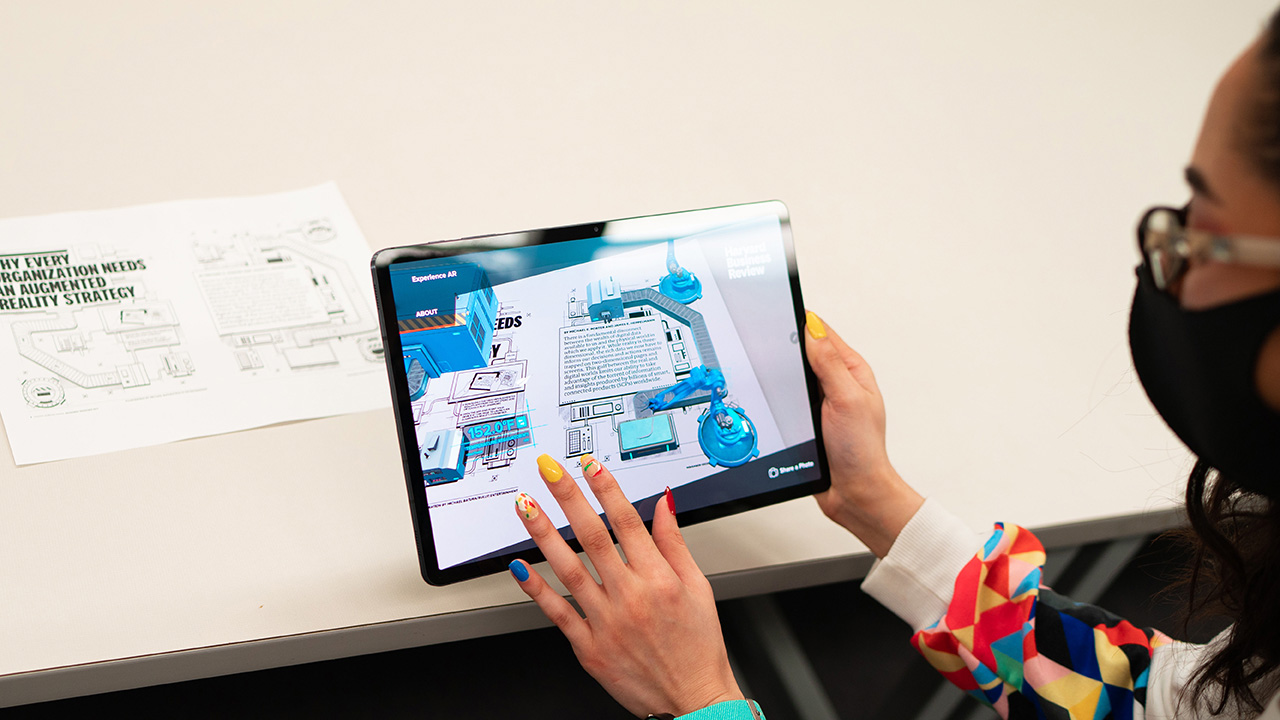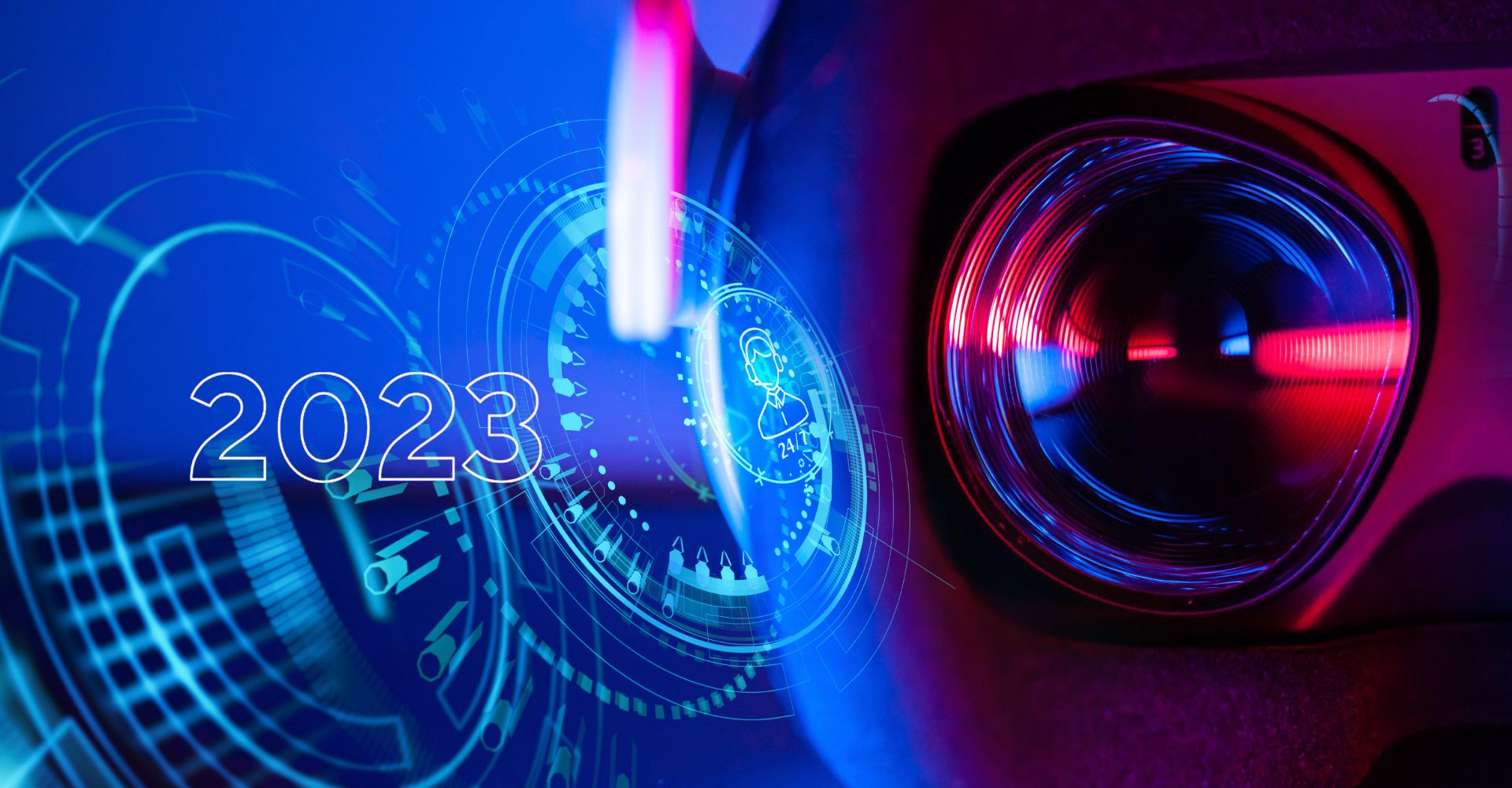Introduction
Welcome to the exciting world of augmented reality (AR) and virtual reality (VR)! These groundbreaking technologies have transformed the way we interact with digital content and have opened up a wealth of possibilities in various industries, including gaming, education, healthcare, and entertainment. Whether you are a developer, designer, or enthusiast, learning AR and VR can be a rewarding and fulfilling journey.
In this comprehensive guide, we will explore the key aspects of learning AR and VR, from building a strong foundation in computer science to mastering the tools and techniques needed for AR and VR development. By the end of this article, you will have a clear roadmap for acquiring the skills and knowledge necessary to create compelling AR and VR experiences.
AR refers to the overlay of digital content onto the real world, enhancing our perception and interaction with the environment. On the other hand, VR immerses users in a completely virtual environment, transforming their sensory experience. Both technologies leverage computer-generated graphics, sound, and other sensory inputs to create a realistic and immersive experience.
To embark on your AR and VR learning journey, it is essential to have a solid foundation in computer science. Understanding fundamental concepts like algorithms, data structures, and software development principles will provide a strong base for working with AR and VR technologies.
Additionally, proficiency in programming languages is crucial for AR and VR development. Languages such as C# and C++ are commonly used with popular AR and VR platforms like Unity and Unreal Engine. These languages enable developers to write code that controls and interacts with virtual objects and environments.
Designing and creating 3D models and assets is another important aspect of AR and VR development. With software tools like Blender and Maya, you can unleash your creativity and bring your virtual worlds to life. A strong understanding of 3D modeling principles and techniques will significantly enhance your AR and VR projects.
In the next sections, we will delve deeper into the various aspects of learning AR and VR, including specific tools, platforms, and techniques. So, fasten your seatbelt and get ready to dive into the immersive world of augmented and virtual reality!
Understanding Augmented Reality and Virtual Reality
Before diving into the world of augmented reality (AR) and virtual reality (VR), it is essential to have a clear understanding of these technologies and their key differences.
AR refers to the overlay of digital content onto the real world, seamlessly integrating virtual elements with the physical environment. Using devices like smartphones, tablets, or AR glasses, users can see and interact with virtual objects or information superimposed on their surroundings. This technology has found applications in various domains, including education, gaming, navigation, and industrial training.
On the other hand, VR immerses users in a completely virtual environment, isolating them from the physical world. Users usually wear a head-mounted display (HMD) to experience a 360-degree view of an artificial world. VR can create realistic simulations that transport users to different locations, eras, or even fantastical realms. It has gained popularity in gaming, entertainment, simulations, and virtual tours.
The key difference between AR and VR lies in the level of immersion. AR enhances the real world with virtual elements, allowing users to interact with both real and virtual objects simultaneously. VR, on the other hand, provides a fully immersive experience by replacing the real world with a virtual environment, isolating the user from their physical surroundings.
Both AR and VR rely on sophisticated technologies to deliver their experiences. Computer vision technology, for example, is used in AR to track real-world objects and understand the user’s environment. This enables accurate positioning of virtual objects and interaction with the real world.
When it comes to creating AR and VR applications, developers need to familiarize themselves with specialized software tools and platforms. Unity and Unreal Engine are widely used game engines that support both AR and VR development. These platforms provide powerful tools for designing, scripting, and testing interactive experiences.
It is important to note that the field of AR and VR is rapidly evolving, with new advancements and innovations constantly emerging. Keeping up with the latest trends and technologies is crucial for staying at the forefront of this exciting industry.
Now that we have a solid understanding of AR and VR, let’s explore the skills and knowledge required to start building amazing augmented and virtual reality experiences.
Building a Strong Foundation in Computer Science
As you begin your journey into augmented reality (AR) and virtual reality (VR) development, it is crucial to establish a strong foundation in computer science. Understanding the fundamental concepts and principles of computing will provide you with the necessary knowledge to work effectively with AR and VR technologies.
Start by familiarizing yourself with the basic concepts of algorithms and data structures. Algorithms are step-by-step procedures used to solve problems, while data structures organize and store data in an efficient manner. A solid understanding of these concepts will help you optimize your AR and VR applications for faster performance and smoother user experiences.
In addition to algorithms and data structures, it is important to grasp the core principles of software development. This includes understanding software engineering methodologies, such as the agile development process and version control systems like Git. By following industry best practices, you can ensure the efficiency, maintainability, and scalability of your AR and VR projects.
Another essential aspect of computer science is understanding computer graphics. AR and VR heavily rely on computer-generated graphics to create immersive and realistic experiences. Familiarize yourself with concepts like rendering, shading, and 3D transformations. This knowledge will help you create visually stunning virtual worlds and objects in your AR and VR applications.
Additionally, it is beneficial to learn about human-computer interaction (HCI) principles. HCI focuses on designing user interfaces and experiences that are intuitive, efficient, and enjoyable for users. By understanding HCI principles, you can create AR and VR applications that are user-friendly and enhance the overall user experience.
Moreover, computer networking plays a significant role in AR and VR development. Understanding concepts such as IP addressing, protocols, and network security will enable you to create multiplayer or networked AR and VR applications. This will allow users to interact with each other in shared virtual spaces or collaborate on tasks.
Continuously keeping up with advancements in computer science is essential for staying ahead in the AR and VR industry. Stay updated with the latest research papers, attend conferences, and participate in online forums and communities that focus on AR and VR technologies. By staying connected with the broader computer science community, you can gain valuable insights and stay abreast of cutting-edge techniques and technologies.
By building a strong foundation in computer science, you will be well-equipped to tackle the challenges and complexities of AR and VR development. So, buckle up and get ready to dive deeper into the exciting world of AR and VR programming!
Learning Programming Languages for AR and VR Development
When it comes to developing augmented reality (AR) and virtual reality (VR) applications, proficiency in programming languages is essential. Programming languages serve as the building blocks for creating interactive and immersive AR and VR experiences. Here are some languages that are commonly used in AR and VR development:
- C#: C# is a popular programming language used with Unity, one of the leading game engines for AR and VR development. With C#, you can write scripts to control the behavior of virtual objects, implement user interfaces, and handle user input. Its object-oriented nature and extensive library support make it a versatile language for AR and VR development.
- C++: C++ is another widely used programming language in AR and VR development, particularly with the Unreal Engine. C++ offers high performance and low-level control, making it suitable for complex and resource-intensive applications. It allows developers to optimize their code for better graphics rendering, physics simulations, and memory management.
- JavaScript: JavaScript is a versatile language commonly used for web-based AR and VR development. It powers interactive user interfaces, animations, and event handling in web browsers. With libraries like A-Frame and Three.js, developers can create immersive AR and VR experiences that can be accessed through a web browser without the need for additional software installations.
- Python: Python is known for its simplicity and versatility, making it a popular choice for AR and VR development. Python can be used to create AR and VR applications, especially for data visualization and scientific simulations. It has a rich ecosystem of libraries and frameworks, such as OpenCV and Pygame, that are beneficial in AR and VR development.
Learning these programming languages will provide you with the foundation to develop interactive and engaging AR and VR experiences. Start by focusing on one language that aligns with your goals, preferences, and the platform you intend to work on.
There are numerous online tutorials, courses, and resources available to help you learn these programming languages. Create small projects to practice and apply your knowledge. Explore sample AR and VR projects to understand how programming languages are used in real-world scenarios.
Engaging with the AR and VR developer community can also be immensely valuable. Participate in forums, attend workshops and meetups, and collaborate with other developers. By sharing knowledge and experiences, you can expand your skillset and stay up-to-date with the latest trends and best practices in AR and VR development.
Remember that learning programming languages is an ongoing process. As technology advances and new tools emerge, staying adaptable and continuously expanding your programming skills will enable you to unlock endless possibilities in the field of AR and VR development.
Creating 3D Models and Designs for AR and VR
One of the key aspects of developing compelling augmented reality (AR) and virtual reality (VR) experiences is creating visually appealing and immersive 3D models and designs. These 3D assets bring virtual worlds and objects to life, enhancing the overall user experience. Here are some important considerations when creating 3D models for AR and VR:
- Software Tools: There are various software tools available for creating 3D models, such as Blender, Maya, and 3ds Max. These tools provide a range of features for modeling, texturing, rigging, and animating 3D objects. Familiarize yourself with these tools and choose the one that aligns with your preferences and requirements.
- Modeling Techniques: Mastering different modeling techniques is essential when creating 3D models for AR and VR. Techniques like polygonal modeling, NURBS modeling, and sculpting allow you to create detailed and realistic objects. Practice different techniques and experiment with various tools to develop your modeling skills.
- Optimization: Optimizing 3D models is crucial to ensure smooth performance in AR and VR applications. Use techniques like simplification, LOD (level of detail) models, and texture optimization to reduce the polygon count and optimize texture usage. This helps in improving rendering speed and reducing the memory footprint of your AR and VR experiences.
- Texturing and Materials: Texturing creates realistic surfaces and enhances the visual appeal of 3D models. Learn techniques like UV unwrapping and texture painting to apply textures and materials to your models. Ensure that you maintain a balance between quality and performance by applying appropriate texture compression and resolution.
- Animation: Animating 3D models can bring them to life, adding interactivity and immersion to your AR and VR experiences. Explore techniques like keyframing, rigging, and procedural animation to create dynamic and engaging animations. Consider the limitations and performance implications of real-time animation in AR and VR applications.
In addition to 3D modeling, designing the virtual environments and scenes in AR and VR is crucial for creating impactful experiences. Consider the following when designing for AR and VR:
- Scale and Proportion: Ensuring accurate scale and proportion is necessary to create a sense of realism and immersion in AR and VR environments. Pay attention to the size and placement of objects to maintain a natural and coherent virtual space.
- User Navigation: Design intuitive and easy-to-navigate environments that allow users to move seamlessly within the AR and VR space. Provide clear visual cues and landmarks to guide users and prevent disorientation.
- Lighting and Shadows: Lighting plays a crucial role in creating a realistic and immersive AR and VR experience. Experiment with different lighting techniques and utilize shadows to enhance depth and realism in your environments.
- Interaction Design: Design interactive elements and user interfaces that are intuitive and easy to use in AR and VR applications. Consider how users will interact with virtual objects and provide feedback to enhance the overall user experience.
Constantly practicing and refining your 3D modeling and design skills will enable you to create captivating and visually stunning AR and VR experiences. Stay inspired by exploring existing AR and VR applications, attending workshops, and engaging with the AR and VR community. This will help you expand your creativity and stay updated with the latest trends and techniques in 3D modeling and design.
Mastering Unity for AR and VR Development
Unity is a powerful and versatile game engine widely used for augmented reality (AR) and virtual reality (VR) development. Mastering Unity will enable you to create immersive and interactive AR and VR experiences. Here are key aspects to focus on when mastering Unity for AR and VR development:
- Interface and Workflow: Familiarize yourself with Unity’s interface and workflow. Understand the structure of scenes and game objects, and learn how to navigate and manipulate them. Get comfortable with working in the Unity editor and utilizing its various panels, menus, and toolbars.
- Scripting: Unity uses C# as its primary scripting language. Develop proficiency in C# to create scripts that control the behavior of virtual objects, handle user inputs, and implement game mechanics. Learn about object-oriented programming (OOP) concepts and Unity-specific APIs to effectively script AR and VR interactions.
- AR and VR Integration: Unity provides built-in support for AR and VR development through packages like AR Foundation and XR Interaction Toolkit. Understand how to set up and configure your projects for AR and VR. Learn how to access AR tracking data, handle VR input, and implement immersive interactions using Unity’s XR APIs.
- Asset Management: Efficiently manage assets in Unity to create optimized AR and VR experiences. Understand the process of importing, organizing, and optimizing 3D models, textures, audio files, and other assets. Utilize Unity’s asset pipeline and compression techniques to reduce file sizes and improve overall performance.
- Scene Design and Optimization: Designing AR and VR scenes that are visually appealing and performant is crucial. Focus on optimizing scene geometry, using LOD (level of detail) techniques, and implementing efficient rendering and lighting setups. Consider performance optimization techniques like occlusion culling and dynamic batching to maintain a smooth framerate.
- User Interaction and UI: Design intuitive and immersive user interactions and user interfaces (UI) in Unity. Utilize Unity’s UI system to create buttons, menus, and HUD elements that enhance the overall user experience. Implement user input mechanisms like touch, gaze, and motion controls for AR and VR interactions.
- Testing and Debugging: Thoroughly test and debug your AR and VR applications to ensure quality and functionality. Utilize Unity’s debugging tools, console, and profilers to identify and fix issues. Test your applications on target devices and utilize Unity Remote to preview and iterate on your AR and VR experiences.
Continuously honing your skills in Unity through practice and experimentation is key. Utilize online tutorials, documentation, and the vibrant Unity community for guidance and inspiration. Stay updated with Unity’s latest features and improvements to leverage new tools and techniques in your AR and VR projects.
Remember, mastering Unity is an ongoing process. Keep pushing your boundaries, experimenting with advanced features, and exploring more complex AR and VR projects. This will allow you to unlock the full potential of Unity and create innovative and immersive AR and VR experiences.
Exploring ARKit and ARCore for Mobile AR Development
ARKit and ARCore are powerful augmented reality (AR) development platforms provided by Apple and Google, respectively. They enable developers to create engaging and immersive AR experiences for mobile devices. Exploring and understanding these platforms is essential for mobile AR development. Here’s what you need to know about ARKit and ARCore:
- ARKit (iOS): ARKit is Apple’s framework for AR development, specifically designed for iOS devices. It provides advanced features like motion tracking, environmental understanding, and light estimation, allowing developers to create realistic and interactive AR experiences on iPhones and iPads. Through the use of Core ML, ARKit also enables integration of AI and machine learning capabilities into AR applications.
- ARCore (Android): ARCore is Google’s platform for AR development, catering to Android devices. It offers similar features to ARKit, including motion tracking, environmental understanding, and light estimation. ARCore supports a wide range of Android devices, enabling developers to reach a large user base with their AR applications.
When exploring ARKit and ARCore, it is important to have a solid understanding of the following key features:
- Motion Tracking: Both ARKit and ARCore use the device’s camera and sensors to track the device’s movement in the real world. This allows virtual objects to be placed and interact with real-world surfaces and environments accurately.
- Environmental Understanding: ARKit and ARCore leverage computer vision and machine learning techniques to understand and analyze the surrounding environment. This enables the detection of horizontal planes, such as floors and tables, for object placement and interaction.
- Light Estimation: Both platforms have the ability to estimate ambient lighting conditions in real-time. This allows virtual objects to be rendered with accurate lighting, enhancing their realism and integration with the real world.
- Anchor and Persistence: Both ARKit and ARCore allow you to create anchors, which are reference points in the AR scene. Anchors enable the persistence of virtual objects in the same location across multiple sessions, enhancing the continuity and user experience of AR applications.
To start exploring ARKit and ARCore, make use of the respective documentation, tutorials, and sample projects provided by Apple and Google. These resources will walk you through the process of setting up AR projects, implementing basic features, and integrating additional functionalities.
Experiment with placing virtual objects on horizontal surfaces, implementing gesture-based interactions, and incorporating physics simulations into your AR applications. Utilize the available APIs and frameworks to access the device’s camera, sensors, and other features to create unique and immersive mobile AR experiences.
Consider factors like performance optimization, user experience design, and cross-platform compatibility when developing with ARKit and ARCore. Adhere to best practices for smooth rendering, efficient memory usage, and responsive user interactions.
As AR technology continues to evolve, stay informed about the latest updates and features of ARKit and ARCore. Apple and Google frequently release updates and improvements to their AR platforms, providing developers with new capabilities and opportunities to create even more engaging and innovative AR applications.
By exploring and leveraging the power of ARKit and ARCore, you can create captivating mobile AR experiences that seamlessly blend the virtual and real world, enhancing user engagement and interaction.
Discovering Mixed Reality with Microsoft HoloLens
Microsoft HoloLens has revolutionized the world of augmented reality (AR) by introducing the concept of mixed reality. Unlike traditional AR devices, HoloLens enables users to interact with holographic objects that seamlessly integrate with the real world. Exploring and understanding the capabilities of HoloLens is essential for unlocking the full potential of mixed reality experiences. Here’s what you need to know about Microsoft HoloLens:
- Mixed Reality: HoloLens combines elements of both AR and virtual reality (VR) to create a mixed reality experience. Users can see and interact with virtual objects that are seamlessly integrated into their real-world environment. This provides an unparalleled level of immersion and interaction.
- Holographic Display: HoloLens incorporates advanced optics and sensors to project holographic images directly onto the user’s field of view. This allows users to view and interact with virtual objects as if they were physically present in the real world.
- Spatial Mapping: Using the depth-sensing cameras and sensors, HoloLens can map the user’s surroundings in real-time. This enables the precise placement and interaction of holographic objects with real-world surfaces, creating a truly immersive mixed reality experience.
- Gestural and Voice Control: HoloLens provides intuitive ways to interact with holographic objects. Users can use hand gestures and voice commands to manipulate and control virtual objects within their environment. This enables natural and immersive interactions in mixed reality applications.
- Development Tools: Microsoft provides the HoloLens Development Edition, which offers a comprehensive set of tools and resources for building mixed reality applications. The HoloLens Development Kit (HDK) includes the necessary APIs, documentation, and developer support to create innovative and immersive experiences.
- Spatial Sound and Spatial Mapping: HoloLens incorporates spatial sound technology, allowing users to hear virtual objects in 3D space. This enhances the overall immersion and realism of mixed reality experiences. Additionally, spatial mapping enables the accurate positioning and interaction of virtual objects based on real-world surfaces.
To get started with HoloLens development, familiarize yourself with the HoloLens Development Edition and the associated development tools. Microsoft provides HoloLens-specific APIs and the Unity game engine integration to create mixed reality applications. Unity’s mixed reality toolkit (MRTK) offers a range of pre-built components and scripts to simplify the development process.
Experiment with holographic object manipulation, spatial understanding, spatial sound, and gaze-based interactions in your mixed reality applications. Learn best practices for designing user interfaces, optimizing performance, and utilizing HoloLens-exclusive features.
Engage with the HoloLens developer community through forums, meetups, and online resources to gain insights, share experiences, and collaborate on mixed reality projects. Microsoft also provides documentation, tutorials, and sample projects to guide you through the development process.
Stay updated with the latest advancements in HoloLens technology. Microsoft regularly releases updates and improvements to the HoloLens platform, which may introduce new features and capabilities to enhance mixed reality experiences.
By discovering and harnessing the power of Microsoft HoloLens, you can create groundbreaking mixed reality applications that merge the virtual and real world, offering a truly immersive and interactive user experience.
Understanding Spatial Computing with Magic Leap
Magic Leap is a pioneering company that has pushed the boundaries of augmented reality (AR) with its spatial computing technology. By merging the physical and digital worlds, Magic Leap enables users to interact with virtual objects in a seamless and natural way. Understanding the concepts and capabilities of spatial computing with Magic Leap is crucial for developing immersive AR experiences. Here’s what you need to know:
- Spatial Computing: Spatial computing refers to the integration of digital content into the user’s physical environment in a way that it appears to coexist and interact with the real world. Rather than placing virtual objects on top of a camera feed, spatial computing enables virtual objects to be anchored to physical surfaces and objects, resulting in a more realistic and immersive experience.
- Lightfield Technology: At the core of Magic Leap’s spatial computing technology is its unique lightfield display. This display projects images directly onto the user’s retina, mimicking the way light interacts with objects in the real world. It creates a sense of depth and realism that enhances the illusion of virtual objects seamlessly blending into the environment.
- 6DoF Tracking: Magic Leap devices utilize advanced sensors and cameras to track the user’s movements with six degrees of freedom (6DoF). This means that the device can accurately track the user’s position and orientation in 3D space, allowing for precise positioning and interaction of virtual objects.
- Hand Tracking: Magic Leap offers hand tracking capabilities, enabling users to interact with digital content using natural hand gestures. This adds a new dimension of interaction and immersion, as users can intuitively manipulate and control virtual objects with their hands.
- World Mapping: Magic Leap spatially maps the user’s environment in real-time, creating a dynamic understanding of the physical space. This allows virtual objects to interact with real-world objects and surfaces in a realistic way, enhancing the sense of presence and realism in AR experiences.
- Development Tools: Magic Leap provides a software development kit (SDK) that allows developers to create AR applications for Magic Leap devices. The Magic Leap SDK includes APIs, tools, and resources for building spatial computing experiences and integrating with Unity and Unreal Engine.
To understand spatial computing with Magic Leap, familiarize yourself with the development tools and resources provided by Magic Leap. Experiment with the capabilities of spatial mapping, 6DoF tracking, and hand tracking to create interactive and immersive AR applications.
Explore the Magic Leap developer documentation, tutorials, and sample projects to gain a deeper understanding of the spatial computing concepts and best practices. Engaging with the Magic Leap developer community can also provide valuable insights and opportunities for collaboration.
As spatial computing continues to evolve, stay informed about the latest updates and advancements from Magic Leap. The company regularly releases updates to its devices and software, introducing new features and capabilities that can enhance the spatial computing experiences offered by Magic Leap.
By understanding spatial computing with Magic Leap, you can push the boundaries of augmented reality and create compelling, immersive AR applications that seamlessly blend the digital and physical worlds.
Exploring Web-based AR and VR Development
Web-based augmented reality (AR) and virtual reality (VR) development offer exciting possibilities in creating immersive experiences that can be accessed through web browsers. Exploring and understanding web-based AR and VR development enables developers to reach a broader audience without the need for additional software installations. Here’s what you need to know:
- WebXR API: The WebXR API is a standard developed by the WebXR Device API Community Group, enabling AR and VR experiences within web browsers. It provides a unified way to interact with various AR and VR devices and platforms, including headsets, mobile devices, and smart glasses.
- Web-based AR: Web-based AR allows users to experience augmented reality directly through a web browser, without the need for dedicated AR apps. With technologies like WebRTC and WebXR, developers can access the user’s camera and sensors through the browser and overlay virtual objects onto the real world.
- Web-based VR: Web-based VR enables users to immerse themselves in virtual reality experiences directly through a web browser. Through frameworks like A-Frame and libraries like Three.js, developers can create interactive and immersive VR scenes that users can explore using headsets or their device’s motion sensors.
- WebGL and WebVR: WebGL is a technology that brings hardware-accelerated 3D graphics to web browsers. It enables developers to create rich and interactive 3D experiences for both AR and VR. WebVR, an API built on top of WebGL, allows for easy integration of VR devices and seamless VR experiences in web browsers.
- Web-based Tools and Frameworks: Various tools and frameworks are available for web-based AR and VR development. A-Frame, Babylon.js, and Three.js are popular frameworks that provide components and APIs to simplify the creation of web-based AR and VR experiences. These tools abstract the complexity of WebGL and provide easy-to-use interfaces for developers.
To explore web-based AR and VR development, start by gaining a solid understanding of HTML, CSS, and JavaScript. Familiarize yourself with WebGL and explore libraries and frameworks like A-Frame, Babylon.js, and Three.js to create interactive and immersive web-based AR and VR experiences.
Experiment with features like real-time video processing, marker-based and markerless tracking, spatial mapping, and interactive 3D elements in your web-based AR projects. For web-based VR, consider implementing intuitive user interactions, creating realistic virtual environments, and optimizing performance for smooth and responsive experiences.
Consider the limitations of web-based AR and VR, such as device compatibility, performance constraints, and security considerations. Ensure that your AR and VR experiences are optimized for different devices and browsers and provide fallback options for unsupported features.
Stay updated with the latest advancements in web technologies, as the web evolves to provide even more powerful capabilities for AR and VR development. Engage with the web development community, attend conferences, and explore online resources to stay informed and collaborate with fellow developers.
By exploring web-based AR and VR development, you can create accessible and interactive experiences that can be enjoyed by a wide range of users directly through their web browsers, pushing the boundaries of what is possible in AR and VR.
Enhancing User Experience in AR and VR Applications
Creating a seamless and immersive user experience is crucial in augmented reality (AR) and virtual reality (VR) applications. A well-designed user experience not only captivates users but also ensures optimal engagement and satisfaction. Here are some key factors to consider when enhancing the user experience in AR and VR applications:
- Intuitive Interactions: Design interactions that are intuitive and easy to understand for users. Ensure that users can navigate and interact with virtual objects naturally and effortlessly. Consider using gesture-based controls, gaze-based interaction, or motion controllers to facilitate interaction in AR and VR environments.
- Visual Design: Pay attention to the visual design of your AR and VR applications. Create visually appealing user interfaces and environments that are consistent, visually balanced, and aligned with the overall theme or purpose of the application. Utilize appropriate colors, contrast, and textures to enhance the visual experience.
- Realism and Immersion: Strive for realism and immersion in AR and VR applications. Pay attention to details like textures, lighting, and sound to create a more realistic and immersive environment. Incorporate spatial audio or binaural sound to enhance the audio experience and provide users with a greater sense of presence.
- Performance Optimization: Optimize the performance of your AR and VR application to provide a seamless and enjoyable experience. Ensure smooth framerates, minimize latency, and optimize resource usage to avoid interruptions or discomfort for users. Consider techniques like occlusion culling and level-of-detail rendering to maintain optimal performance.
- Comfort and Ergonomics: Prioritize user comfort and ergonomics in VR applications. Pay attention to factors like motion sickness, eye strain, and user fatigue. Design user interfaces and interactions that minimize discomfort and provide appropriate breaks or prompts for users to rest or readjust.
- Guidance and Feedback: Provide clear guidance and feedback to users. Help users understand how to interact with the application and provide appropriate visual or auditory cues to indicate successful interactions or actions. Use tooltips, tutorials, or interactive guides to onboard users and make the application more user-friendly.
- User Testing and Feedback: Conduct user testing and collect feedback to understand the user experience from the perspective of actual users. Incorporate feedback to improve usability, address pain points, and enhance the overall user experience. Regularly engage with your user community to learn from their experiences and continuously iterate on your AR and VR applications.
Remember, the user experience is a critical aspect of AR and VR applications. Continuously strive to improve usability, interaction, comfort, and immersion to create compelling and engaging experiences that keep users coming back for more.
Integrating Artificial Intelligence in AR and VR
Integrating artificial intelligence (AI) into augmented reality (AR) and virtual reality (VR) applications opens up a world of possibilities, enhancing interactivity and personalization. By leveraging AI technologies, AR and VR experiences can become more immersive, intelligent, and adaptive. Here are some key considerations for integrating AI in AR and VR:
- Object Recognition and Tracking: AI algorithms can be used to recognize and track objects in AR and VR environments. This enables the detection of real-world objects, allowing virtual content to interact with them seamlessly. Object recognition can enhance user interactions and create more realistic and engaging AR and VR experiences.
- Natural Language Processing: By integrating natural language processing (NLP) capabilities, AR and VR applications can understand and respond to voice commands, enabling more intuitive and natural interactions with virtual objects. Users can communicate with AI-powered virtual characters or give verbal instructions to control the application’s behavior.
- Gesture and Emotion Recognition: AI-based algorithms can analyze user gestures and facial expressions to recognize emotions and intent. This allows AR and VR applications to respond dynamically based on the user’s actions and emotional state. Gesture recognition enables users to interact with virtual objects using hand gestures, while emotion recognition can enhance storytelling and character interactions.
- Personalization and Recommendation: AI can enhance personalization in AR and VR applications by analyzing user preferences and behaviors. By collecting and analyzing data, the application can adapt and tailor the experience to individual users, providing personalized content and recommendations. This creates a more engaging and customized environment for each user.
- Simulations and AI Characters: AI algorithms can be used to create realistic simulations and intelligent characters in AR and VR applications. These virtual characters can exhibit dynamic behaviors, respond to user interactions, and showcase advanced social intelligence. AI-driven simulations and characters offer a more lifelike and interactive experience for users.
- Contextual Understanding: AI algorithms can analyze the contextual information in AR and VR environments, allowing the application to understand the surroundings and adjust the virtual content accordingly. Contextual understanding enables better object placement, spatial mapping, and spatial audio, making the virtual objects feel more integrated and realistic within the user’s environment.
Integrating AI in AR and VR applications requires a combination of AI algorithms, machine learning models, and data processing techniques. Utilize AI frameworks and libraries like TensorFlow, PyTorch, or OpenAI to implement AI capabilities in your AR and VR applications.
Consider privacy and ethical implications when integrating AI in AR and VR. Ensure that user data is handled securely and transparently. Be mindful of bias and fairness in AI algorithms, and seek to create inclusive and equitable experiences for all users.
Continuously explore advancements in AI technologies and learn from the AI developer community. Experiment with new techniques, algorithms, and models to enhance the intelligence and interactivity of your AR and VR applications.
By integrating AI into AR and VR, you can create intelligent, adaptive, and immersive experiences that revolutionize the way users interact and engage with virtual content. Embrace the power of AI to unlock the full potential of AR and VR applications.
Testing, Debugging, and Optimizing AR and VR Applications
Testing, debugging, and optimizing are crucial steps in the development process of augmented reality (AR) and virtual reality (VR) applications. These steps ensure that your AR and VR experiences are seamless, performant, and provide an optimal user experience. Here are key considerations:
- Functional Testing: Perform comprehensive functional testing to ensure that all features and functionalities of your AR and VR application are working as intended. Test for edge cases, handle user interactions, and validate the accuracy of tracking and object placement. Address any issues or bugs that are identified during testing.
- User Experience Testing: Conduct user experience testing to gain insights into how users interact and respond to your AR and VR application. Gather feedback on the usability, intuitiveness, and overall satisfaction of the user experience. Iterate on your design and implementation based on user feedback to enhance the overall user experience.
- Performance Optimization: Optimize the performance of your AR and VR application to ensure smooth rendering, low latency, and high frame rates. Optimize resource usage, such as memory and CPU utilization, to avoid performance bottlenecks. Implement techniques like level-of-detail rendering, occlusion culling, and asset optimization to improve performance.
- Quality Assurance: Establish a robust quality assurance process to catch any bugs or glitches before releasing your AR and VR application. Conduct rigorous testing on different devices, platforms, and configurations to ensure compatibility and functionality across a range of environments. Utilize automated testing tools and frameworks to streamline the testing process.
- Debugging: Debugging is a critical step in identifying and fixing issues or unexpected behaviors in your AR and VR application. Utilize debugging tools and techniques provided by AR and VR development platforms or IDEs. Use logs, breakpoints, and stack traces to pinpoint the cause of issues and fix them accordingly.
- User Feedback: Encourage users to provide feedback on your AR and VR application. Monitor user reviews, comments, and support channels to identify recurring issues or areas for improvement. Actively engage with users by responding to their feedback, addressing their concerns, and continuously iterating on your application based on their input.
- Continuous Improvement: AR and VR technologies are continually evolving. Stay informed about the latest advancements, updates, and best practices in AR and VR development. Continuously seek opportunities to optimize and enhance your AR and VR application by exploring new techniques, integrating new features, and leveraging industry advancements.
Remember to thoroughly test your AR and VR application on target devices and closely emulate the end-user experience. Prioritize the user experience and ensure that your application runs smoothly, performs well, and provides an immersive and engaging experience.
By dedicating time and effort to testing, debugging, and optimizing your AR and VR applications, you can deliver high-quality experiences that captivate users and provide seamless interactions in the exciting world of AR and VR.
Deploying and Distributing AR and VR Apps
Deploying and distributing your augmented reality (AR) and virtual reality (VR) applications to end-users is a critical step in making your creations accessible. To ensure a smooth deployment process, consider the following factors:
- Platform-Specific Guidelines: Each AR and VR platform, such as iOS, Android, or specific headsets, has its own set of guidelines for app submission. Understand the requirements and guidelines of your target platform to ensure your app meets the necessary criteria for distribution.
- Perform Compatibility Testing: Before deploying your AR and VR app, conduct thorough compatibility testing on a variety of devices and platforms to ensure optimal performance and functionality across multiple hardware configurations.
- App Store Submission: If you plan to distribute your app on major app stores, such as the App Store or Google Play, familiarize yourself with the submission process. Adhere to guidelines regarding content restrictions, user consent, privacy policies, and licensing agreements.
- Software Development Kits (SDKs): If you are working with specific AR and VR platforms or devices, utilize the provided software development kits (SDKs) and APIs. These resources offer tools and documentation to facilitate app deployment and integration with the hardware ecosystem.
- Over-The-Air (OTA) Distribution: In addition to app stores, consider alternative distribution methods like over-the-air (OTA) deployment. This allows users to install your app directly from a website or a dedicated server, simplifying the distribution process.
- Public Beta Testing: Conduct a public beta testing phase to gather feedback and identify any issues or bugs before the official release. Engage with beta testers, provide them with guidelines, and encourage them to share their experiences and report any problems they encounter.
- User Support and Documentation: Ensure that your AR and VR app includes proper user support and documentation. Provide clear instructions, FAQs, and a feedback mechanism for users to report issues or seek assistance. Regularly update your documentation to address user feedback and incorporate new features or functionality.
- Marketing and Promotion: Develop a marketing strategy to promote your AR and VR app to your target audience. Leverage social media platforms, app directories, and innovative marketing techniques to raise awareness and drive downloads.
- Continuous Updates: After releasing your AR and VR app, continue to iterate and improve upon it. Regularly update your app based on user feedback, fix bugs, and introduce new features to ensure user satisfaction and keep up with evolving technologies.
Keep in mind that distribution channels and procedures may vary based on the platforms and devices you target. Stay informed about the latest updates and changes to app store policies or platform-specific guidelines to ensure compliance and a successful deployment.
By carefully considering deployment options, adhering to guidelines, and prioritizing user support and user experience, you can effectively deploy and distribute your AR and VR apps, reaching and engaging a wide user base in the exciting world of AR and VR.
Keeping Up with the Latest AR and VR Trends
The fields of augmented reality (AR) and virtual reality (VR) are dynamic and constantly evolving. To stay ahead in this fast-paced industry, it’s crucial to keep up with the latest trends and innovations. Here are some effective strategies to remain informed and up-to-date:
- Follow Industry News and Blogs: Stay informed by following industry-related news, blogs, and publications. Subscribe to newsletters, RSS feeds, and social media accounts of influential industry leaders and organizations. This ensures you receive timely updates on new technologies, advancements, and important development trends.
- Engage in Online Communities: Join online forums and communities dedicated to AR and VR development. Participate in discussions, ask questions, and share your knowledge and experiences. Engaging with the developer community provides valuable insights into emerging trends, best practices, and challenges faced by others in the field.
- Attend Conferences and Events: Attend AR and VR conferences, workshops, webinars, and meetups. These events offer opportunities to learn from industry experts, network with like-minded professionals, and gain insights into the latest research, technologies, and practical techniques. Stay updated on upcoming events through professional organizations, social media platforms, and event directories.
- Explore Research Papers and Case Studies: Stay abreast of the latest research and academic papers related to AR and VR. Explore research published by universities, research institutions, and industry leaders. Additionally, read case studies of successful AR and VR applications to understand best practices and learn from real-world examples.
- Experiment with New Tools and Platforms: Continuously experiment with new tools, software, and development platforms. Try out beta versions, participate in early access programs, and explore emerging technologies. Embracing new tools and platforms allows you to gain hands-on experience with cutting-edge advancements and stay ahead of the curve.
- Participate in Hackathons and Challenges: Engage in hackathons, coding challenges, and innovation competitions focused on AR and VR development. These events encourage creativity, collaboration, and problem-solving. They also provide an opportunity to work on real-world projects and learn from peers while staying updated with the latest trends and technologies.
- Collaborate with Industry Professionals: Collaborate with professionals from different disciplines within the AR and VR industry. Engage in cross-disciplinary projects, join open-source communities, and seek partnerships. By working together, you can pool your knowledge and expertise to drive innovation and stay at the forefront of the industry.
- Continuing Education and Online Courses: Invest in your education by enrolling in online courses, certifications, or bootcamps that focus on AR and VR development. Platforms like Udemy, Coursera, and LinkedIn Learning offer courses taught by industry experts. Continuous learning ensures you are equipped with the latest skills and knowledge to excel in AR and VR development.
Remember that the AR and VR landscape is constantly evolving. Be open to learning from others, investing time in self-improvement, and embracing innovation. By actively staying informed and engaging with the AR and VR community, you can keep up with the latest trends and contribute to the advancement of this exciting industry.












